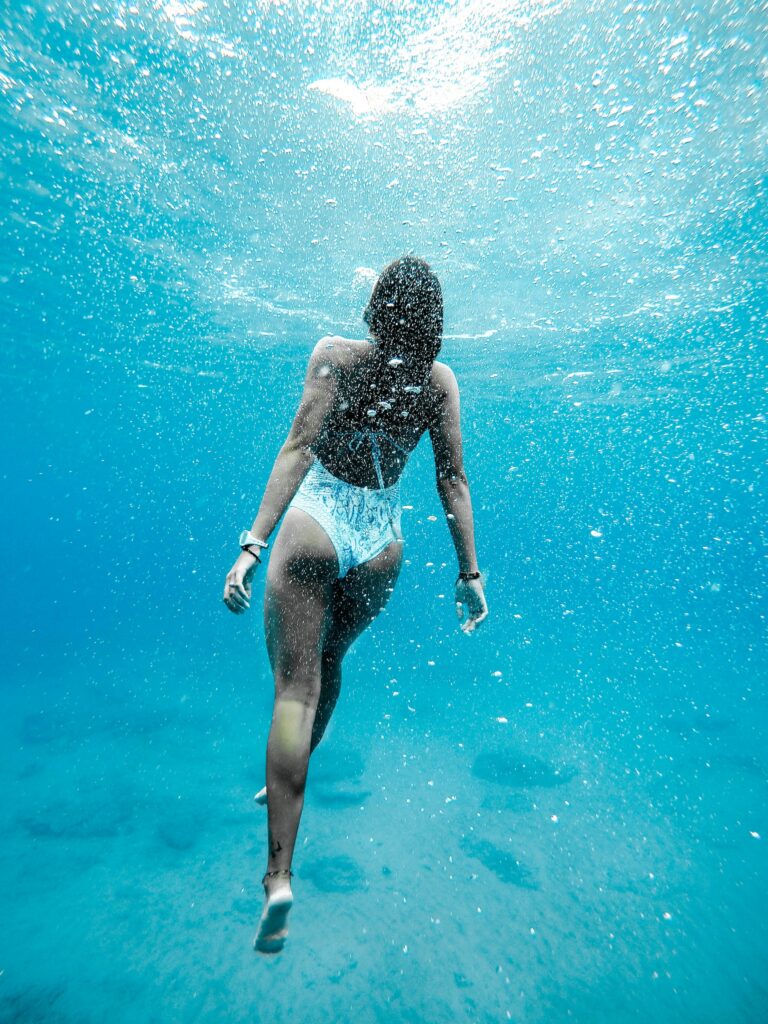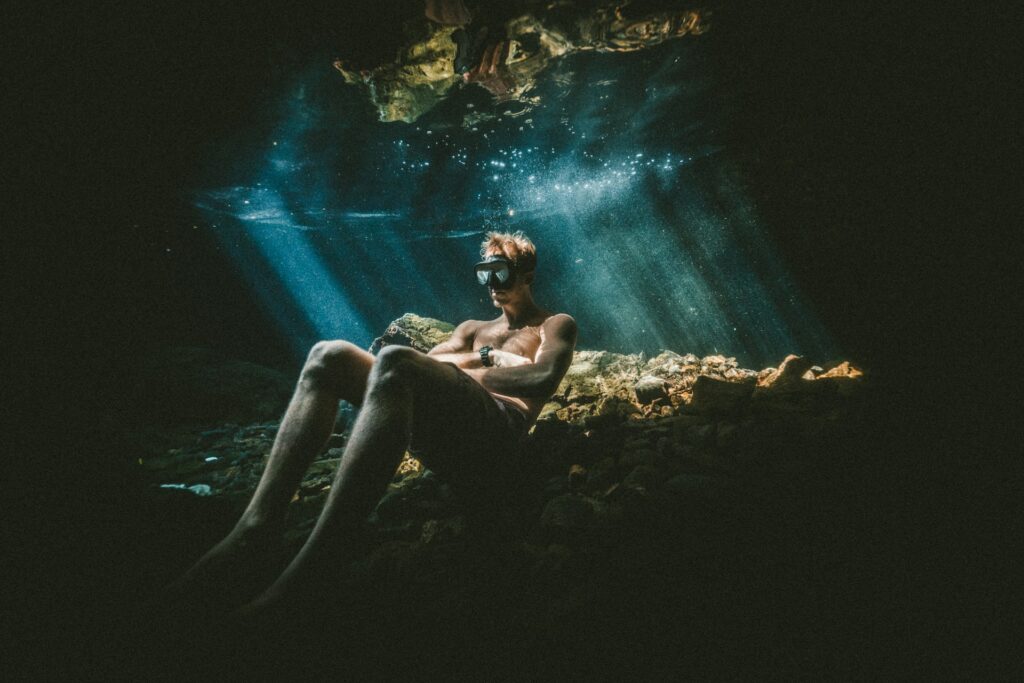Table of Contents
I’ve taken my sunscreen-laden research quest to experts in dermatology and physics to bring you a blog post that is informative and as refreshing as a dip in the pool. Prepare yourself to dive beneath the surface of common knowledge and come up with pearls of wisdom you can apply next time you’re out catching rays.
In this post, we will dissect the science behind sunlight, how it penetrates water, and its effects on our skin. We’ll also discuss the role of Sunscreen, even when you’re neck-deep in your favorite swimming spot. Whether you’re a sunbathing enthusiast or love swimming, this post will equip you with the essential knowledge to keep your skin glowing and healthy. At the same time, you indulge in your favorite summertime activities.
The Science of Tanning: A Deep Dive
Grab your lab coats, because we’re about to dive into the fascinating world of tanning science! Don’t worry though, I’ll keep it light, fun, and easy to understand, just like we’re chatting over lattes at our favorite café!
A Little Sun Magic: The UV Impact
Let’s start with the basics. So, when your skin is exposed to the sun, it responds to the ultraviolet (UV) radiation from the sun’s rays. UV radiation is divided into three types: UVA, UVB, and UVC. Thankfully, the earth’s atmosphere filters out UVC, but UVA and UVB can both reach your skin and cause it to tan.
Here’s how it works: UVB rays kickstart the tanning process by affecting the uppermost layer of the skin, the epidermis. They stimulate special cells called melanocytes to produce melanin, the pigment responsible for your tan (and, fun fact, your hair and eye color!).
UVA rays, which penetrate deeper, into the dermis, oxidize this melanin, causing it to darken – voilà, you’re tanned!
Not All Skins Are Created Equal
We’ve all got that one friend who turns a luscious shade of gold after just a few minutes in the sun, while others of us might look more like lobsters! This is because the amount and type of melanin you have are primarily determined by genetics.
There are two types of melanin: eumelanin, which is brown or black and gives skin a tan or brown color, and pheomelanin, which is yellow or red and can cause skin to freckle or burn. People with more eumelanin tend to tan more easily and are less likely to burn, while those with more pheomelanin burn more easily and are less likely to tan.
The Dark Side of the Sun
Unfortunately, while a glowing tan might look great, it’s actually a sign that your skin has been damaged by the sun. The production of melanin is your skin’s way of trying to protect itself from further damage. And over time, this damage accumulates, leading to premature aging (think wrinkles, fine lines, and age spots), and in worse cases, skin cancer.
Anyone can get skin cancer, but people with less melanin (those who burn more easily) are at a higher risk. This is why it’s so essential to protect all skin types from excessive sun exposure. And remember, even when it’s cloudy, up to 80% of UV rays can still reach your skin, so don’t skip the sunscreen!
Sun-Kissed or Sun-Missed: The Truth About Underwater Tanning

Who wouldn’t love the idea of lounging on a comfy beach towel, basking in the sun’s glow? But let’s face it – it can get pretty hot out there, and we’re not even touching on the UV damage yet!
So, I bet some have asked: what about tanning underwater? The theory is that the water filters the sun’s UV rays and protects your skin from burning by bouncing them off instead of allowing them to hit your skin directly. As someone with fair skin, I’ve found that tanning underwater lets me build up my melanin levels slowly and safely without the fear of turning into a lobster. And honestly, who wants to lug around beach towels and umbrellas when you could dive in? It’s all about that minimalist beach life!
How to Achieve a Perfect Underwater Tan
Underwater tanning is an art, so let’s walk through it. You’ll need to safeguard your skin first by wearing sun-protective clothing, like a rash guard or swim shirt. Remember, it’s all about the glow, not the burn. Once you’re all set, ensure the water’s warm enough for a long, leisurely soak. Trust me; nobody likes goosebumps while they’re trying to tan. And while you’re at it, grab a relaxing float or inner tube.
For an even, gorgeous tan, gradually build up your exposure time over days or weeks. And remember to rotate in the water so that every part of your body gets an even amount of sun. Lastly, apply your SPF 30+ sunscreen once you step out of the water and into direct sunlight.
Diving Deep: The Benefits of Underwater Tanning

Underwater tanning is like a cool, refreshing drink for your skin. Thanks to water’s reflective properties, it shields your skin from harmful radiation. Plus, it helps cool your body temperature while allowing enough sun exposure for melanin production.
And let’s remember the bonus of accessing all those hard-to-reach spots while floating and spinning in the water. Plus, there’s something truly therapeutic about the seawater’s natural minerals that make the whole experience a delight for your mind and body.
Safety First: The Risks of Underwater Tanning
While underwater tanning might seem like an exciting and unique way to achieve your desired sun-kissed look, it’s important to remember that it does come with risks, similar to any other type of sun exposure.
- UV Exposure: Just like tanning above water, tanning underwater exposes your skin to harmful ultraviolet (UV) rays from the sun. These UV rays can lead to premature aging, skin damage, and increase your risk of developing skin cancer.
- Inefficient UV Blockage: Water doesn’t completely block UV rays, especially at the surface where underwater tanning typically occurs. This means that you could still receive substantial UV exposure even if you’re submerged.
- Increased Reflection: Water can amplify the sun’s rays, which might increase your UV exposure, especially in a pool or ocean where the surface of the water can act like a mirror, reflecting additional sunlight onto you.
- Reduced Sunscreen Efficiency: Being in water can also reduce the effectiveness of your sunscreen, especially if you’re swimming or moving around a lot. Even “water-resistant” sunscreen can come off, leading to less protection over time.
- Inability to Tan in Murky Water: You cannot tan in murky water because UV rays cannot penetrate through it, which prevents any possibility of tanning.
- Risks of Murky Water: Apart from tanning concerns, swimming in murky waters also comes with potential hazards such as bacteria, viruses, and other microorganisms that could cause serious illness.
Given these risks, it’s essential to take comprehensive precautions when you’re planning on underwater tanning.
Applying Sunscreen Properly: Apply a broad-spectrum sunscreen with an SPF of 30 or higher generously on all exposed skin areas about 15 to 30 minutes before going out in the sun, and certainly before getting into the water. Don’t forget often overlooked spots like the tops of your feet, your ears, and the back of your hands. Once you’re out in the sun and swimming, reapply at least every 2 hours, or immediately after swimming or sweating heavily.
Limiting Time in Water: As for how long to stay in the water, there’s no definitive ‘safe’ duration. However, a good rule of thumb is to take frequent breaks from the sun every 15-20 minutes. Seek shade, hydrate yourself and apply more sunscreen.
Staying Hydrated: In addition to reducing your sun exposure, you need to make sure to drink plenty of water to stay hydrated. The sun can be dehydrating, and being in water can sometimes make us forget that.
Using Additional Protective Measures: Consider additional protective steps like wearing UV-protective swimwear, a broad-brimmed hat, and sunglasses. When possible, seek shade, especially during the peak sunlight hours of 10 a.m. to 2 p.m.
Remember, your skin is delicate, and its health should always be your priority over achieving a tan. Whether you’re tanning underwater or on land, protecting your skin from harmful UV radiation should be your top priority. Always wear a broad-spectrum sunscreen with an SPF of 30 or higher, reapply it regularly, and consider other protective measures like UV-protective swimwear and shade. The most beneficial tan is always a healthy one!
Poolside or Oceanside: Where Do You Tan Quicker?

I remember hopping into my pool the first time, hoping for a quick, efficient tan. Who wouldn’t love to cool off while working on that bronze glow? Water surfaces reflect sunlight, which can amplify your exposure to UV radiation, leading to a faster tan.
But here’s the catch – it depends on how long you’re in the water and the sun’s intensity. I once spent a whole afternoon floating around my pool, covered in Sunscreen. Did I get that bronze goddess look? Nope, not quite.
Sunscreen can reduce your skin’s exposure to UV rays, which limits your ability to tan quickly. And trust me, you don’t want to skip it. I’ve learned from experience that even a half-hour of unprotected exposure can leave your skin looking more lobster than a beach babe.
Muddy Waters: Can You Tan in Murky Water?
You might be curious if it’s possible to tan in murky water. In short nope, you can’t tan in murky water. The particles in murky water block the UV radiation needed for tanning.
More importantly, murky waters can contain harmful microorganisms that can make you sick, not to mention the limited visibility that could lead to accidents. So, it’s a big no for murky waters, beauties. Stick to clear, clean waters for your tanning escapades.
Underwater Hazards: The Skin Cancer Risks of Tanning Underwater

I feel like a broken record, but taking the risk of skin cancer seriously is essential. Tanning underwater doesn’t protect you from the harmful UV radiation from the sun. Skin cancer can occur when UV radiation damages your skin cells and causes them to mutate.
And remember, swimsuits aren’t your armor against UV radiation. I’ve got a drawer full of the cutest swimsuits, but they don’t offer much protection against the sun’s rays. That’s why I always remember to wear waterproof Sunscreen with an SPF of 30 or higher.
Tanning Showdown: Underwater or Tanning Bed?
Let’s settle this once and for all, tanning underwater and using a tanning bed can harm your skin. The reflection of the water can expose your skin to more UV radiation than a tanning bed. And tanning beds emit harmful UVA and UVB rays that can damage your skin.
I’ve tried a tanning bed once or twice in my life, and let me tell you, it’s not worth the risk. Opt for safer alternatives like self-tanners or spray tans. Your skin will thank you!
Quick Dips or Long Swims: Which Tans Faster?

You might have heard rumors that you can tan faster in water. I’ve spent countless hours testing this theory – from quick dips to long, leisurely swims. The consensus? It’s still a mystery.
While some swear by their water-based tanning routine, no definitive scientific evidence supports it. We know that staying hydrated and protecting your skin from intense sun exposure can lead to less burning and potentially quicker tans when combined with traditional sunbathing.
Timing Is Everything: How Long Should You Stay Underwater?

There’s no hard-and-fast rule however, moderation is key. 15 minutes is usually a safe bet. But remember – you need to get sun exposure outside the water, too. Mixing it up can help you achieve your tan goals while minimizing potential health risks. And don’t skimp on the Sunscreen – often reapply to protect your skin.
Conclusion
And there you have it, my sun-soaked lovelies! We’ve dived deep into the world of underwater tanning, and the truth is that it’s a splashy, fun way to achieve that sun-kissed glow, but it comes with risks. Remember, your best bet is to wear protective clothing, lather with SPF 30+ Sunscreen, and stay hydrated. Avoid murky waters and lengthy tanning sessions, and never forget to listen to your body. I know we’re all after that radiant summer glow, but it’s crucial to do it safely. Your skin is precious, and it deserves the best care. So go on, take these tips, and dive in! Your ultimate, healthy, bronzed look awaits you beneath the sun-dappled waves. Happy, safe sunbathing!
Feature image by Stanley Dai on Unsplash




